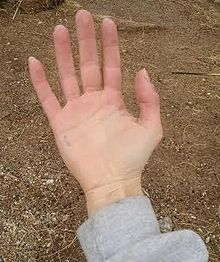Ape hand deformity is a deformity in humans who cannot move the thumb away from the rest of the hand. It is an inability to abduct the thumb.[1] Abduction of the thumb refers to the specific capacity to orient the thumb perpendicularly to the ventral (palmar) surface of the hand. Opposition refers specifically the ability to "swing" the first metacarpal[2] such that the tip of the thumb may touch the distal end of the 5th phalanx and if we put the hand on the table as the palm upward the thumb can not point to the sky. The Ape Hand Deformity is caused by damage to the distal median nerve (also called a Median Claw lesion), and subsequent loss of opponens pollicis muscle function. The name "ape hand deformity" is misleading, as some apes do have opposable thumbs.[citation needed]
| Ape hand deformity | |
|---|---|
| Other names | Simian hand |
 | |
| Ape hand deformity | |
It can occur with an injury of the median nerve either at the elbow or the wrist, impairing the thenar muscles and opponens pollicis muscle.[3]
Ape hand deformity is one aspect of median nerve palsy, which is usually caused by deep injuries to the arm, forearm and wrist area.[citation needed]
Additional images
editApe hand caused by median and ulnar nerve lesions.
See also
editReferences
edit- ^ "Anatomy Tables - Hand". Archived from the original on 2008-01-18. Retrieved 2009-11-02.
- ^ Belliappa, P. P.; Scheker, L. R. (August 1993). "Functional anatomy of the hand". Emergency Medicine Clinics of North America. 11 (3): 557–583. doi:10.1016/S0733-8627(20)30467-3. ISSN 0733-8627. PMID 8359131.
- ^ "Gross Anatomy: THE BRACHIAL PLEXUS". Archived from the original on 2009-09-04. Retrieved 2009-11-02.